Standard [CURRENT]
ASTM C 1181/C 1181M:2017
Standard Test Methods for Compressive Creep of Chemical-Resistant Polymer Machinery Grouts
- German title
- Druckstandversuche an chemisch beständigen Polymervergußmassen für den Maschinenbau
- Publication date
- 2017
- Original language
- English
- Pages
- 4
- Publication date
- 2017
- Original language
- English
- Pages
- 4
Product information on this site:
Quick delivery via download or delivery service
Buy securely with a credit card or pay upon receipt of invoice
All transactions are encrypted
Short description
1.1 These test methods cover a quantitative, comparative test for compressive creep of chemical-resistant grouting materials under a sustained load at a test temperature. Constant load is maintained using a bolt and spring washers. Measurements are made at laboratory temperature after exposure periods at the selected test temperature. 1.2 Test Method A outlines the molding techniques for an unbonded test specimen. Test Method B covers the molding techniques for a bonded test specimen. 1.3 The values stated in either SI units or inch-pound units are to be regarded separately as standard. The values stated in each system may not be exact equivalents; therefore, each system shall be used independently of the other. Combining values from the two systems may result in non-conformance with the standard. 1.4 This standard does not purport to address all of the safety concerns, if any, associated with its use. It is the responsibility of the user of this standard to establish appropriate safety, health, and environmental practices and determine the applicability of regulatory limitations prior to use. 1.5 This international standard was developed in accordance with internationally recognized principles on standardization established in the Decision on Principles for the Development of International Standards, Guides and Recommendations issued by the World Trade Organization Technical Barriers to Trade (TBT) Committee.
Also available in
Loading recommended items...
Loading recommended items...
Loading recommended items...
Loading recommended items...

